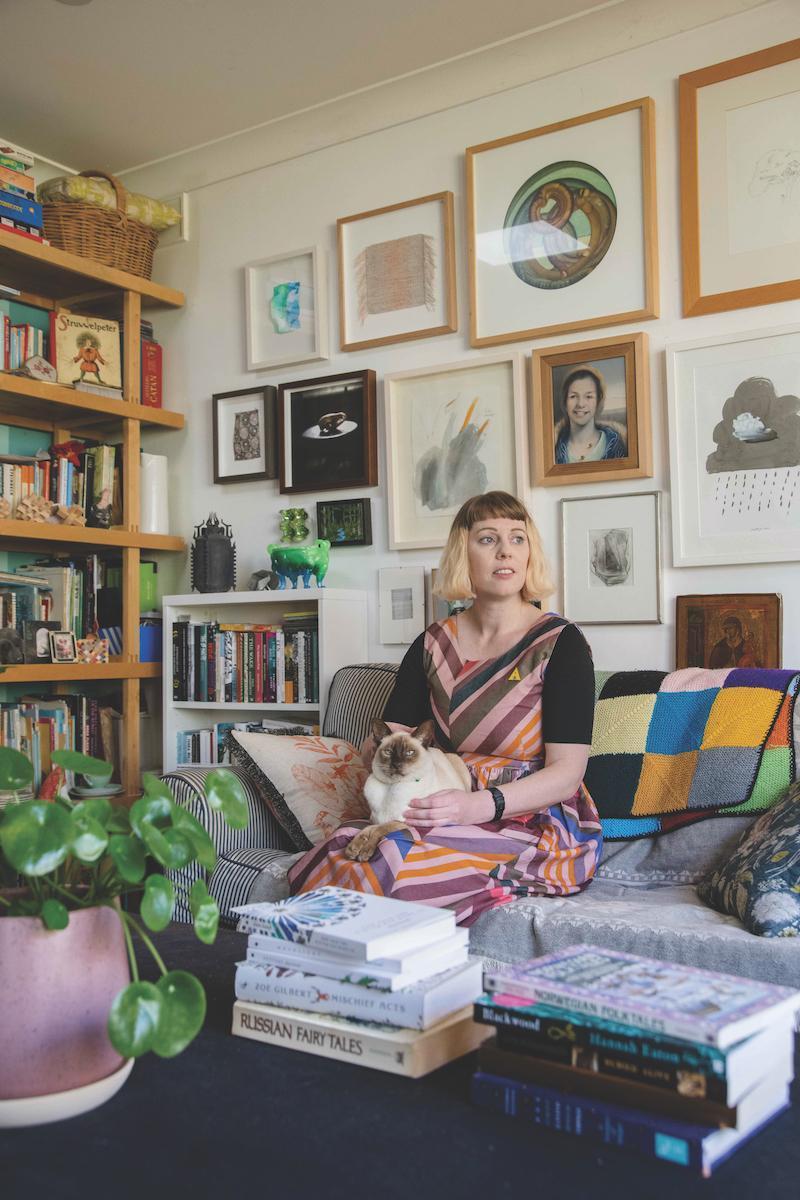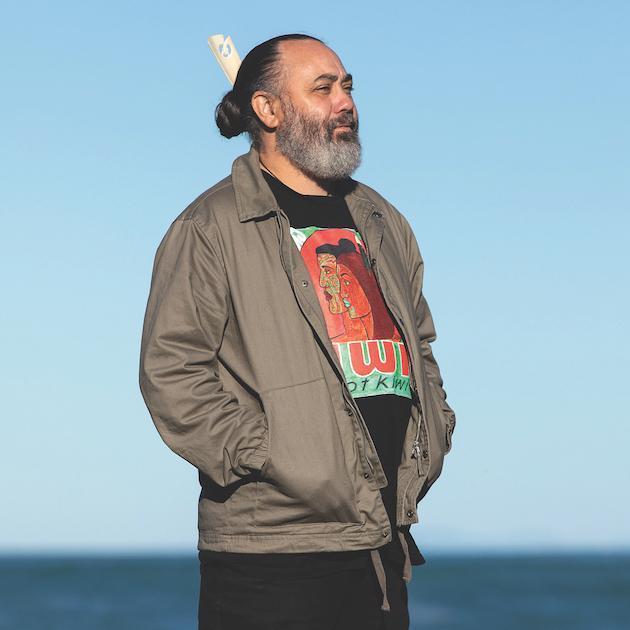The Beckoning
Julia Robinson’s ingenious soft sculptures are a folk horror, feminist and fashion history take on the smock dress.
Words: Joanna Kitto
Photography: Jack Fenby
For her first solo exhibition at Hugo Michell Gallery, Adelaide, Julia Robinson brings a career-long fascination with the 1973 cult classic The Wicker Man into focus. Titled The Beckoning Blade, this series of sculptural works draws on the film as a lens through which to examine pre-Christian rituals relating to fertility, the seasons, and cycles of growth and decay. This is the body of work Robinson’s practice has been building towards. This is her love letter to folk horror.
Grounded in the struggle for survival on the land, Robinson acknowledges that folklore is inherently dark, and it doesn’t take much to sift the horror to the surface. In agricultural living, life and death are pressed up against each other. One bad harvest can bring about the end. The Beckoning Blade captures this knife’s edge between bucolic and sinister that folk horror hinges its tension upon.
With more than 18 meticulously constructed artworks, Robinson brings agricultural garments and tools to life, effectively creating a cast of characters – and the objects they might use to plough the earth or hold aloft on May Day – in her own folk horror fantasy.
She takes the humble smock as her starting point. A linen outer garment worn by rural workers across Medieval England, smocks were re-introduced in the 18th century for the same purpose. In the 1970s, the smock and smocking (the honeycomb pattern embroidered on the surface) were popularised in fashion by the hippy movement, signalling the freedoms of peasant life and a count- er-cultural rejection of the buttoned-up looks of Capitalism. This history provides a through- line for Robinson, representing an important trope in folk horror; what at first appears to be a benign agricultural staple is, on second glance, laden with meaning and narrative potential.
The work’s lurid colour palette borrows from The Wicker Man’s contemporary counterpart, Ari Aster’s Midsommar, 2019. In this film, American outsiders visit the remote Swedish community of the Hårga and the horror unfolds in the bright sunshine that blankets the idyllic setting for nearly 24 hours a day.
Ominous motifs are found throughout The Beckoning Blade. The lost child, the rot in the yield, the hare (the latter with an artful title: The Lurker at Dusk). In Comes I visually references the mystical power of three, recognisable as the ancient symbol of the triskelion seen in the flag of the Isle of Man. Its title borrows from a Mummers’ play (folk plays performed by troupes of amateur actors, traditionally all male) performed at Winter Solstice to stimulate change and beckon in the new season, which opens with an actor barging into a room shouting the titular cry. Much like a scarecrow’s form is built from farm implements stuffed into clothing, Robinson creates her anthropomorphised performer from a scythe blade cloaked in two smocked arms – or more unsettlingly, running legs.
A film is nothing without its soundtrack, and The Wicker Man has been referred to as a musical for the way songs, written and performed by Paul Giovanni and Magnet, are woven through the narrative. Robinson compliments her folk horror by engaging fiction writer Sean Williams to produce Nine Lullabies, poems – or songs – of his own invention, printed and bound by Damien Warman and offered to the audience.
As an artist living in Australia, Robinson is separated from the homeland of her British ancestry and her practice has been shaped by research into European history and literature, particularly the naturalistic and pagan rituals of folk culture and the ways they are translated into folk horror. In this way, Robinson is the knowledgeable outsider while her audience is positioned as the unassuming visitor who will either embrace the community’s ways, or glance at every sharp blade, unusual act, and unfamiliar object with suspicion, and whose distrust will only lead to a grisly end.
Perhaps the most enticing element of folk horror is the intoxicating potential of the collective. Sitting as an exclamation point to The Beckoning Blade is Sunspurge, 13 interlock- ing sleeves forming the imagery of a sun. The dip-dyed linen turns from bright straw-yellow to royal purple, mimicking the vivid colours worn by Lord Summerisle during the island’s portentous May Day festivities. The many arms evoke the unified movements in folk dancing, particularly the Maypole dance, and the way performing the same motions together can induce a shared experience. In Midsommar the Hårga wail, moan and thrash their bodies in expression of the pleasure and pain of their fellows. The end point of The Wicker Man sees the community of Summerisle perform a gruesome act in unison, their burden lightened by their numbers. As this scene signals the climax of the film, so too does the setting sun gesture towards finality. Nature’s most keenly observed cycle comes to an end, and we await it to begin again.
HUGO MICHELL
Director, Hugo Michell Gallery, Adelaide
We have represented Julia since early 2019, however The Beckoning Blade marks Julia’s first solo exhibition with the gallery as in this time she has produced two major bodies of work for two significant institutional presentations. In 2020 Julia was included in the Adelaide Biennial: Monster Theatres, which resulted in the entire body of work being acquired by the Art Gallery of South Australia, with significant support from the Adelaide Biennial Ambassadors. There is a demand for her work, given its recent success. [Her new works are] priced between $6,500 and $9,000.
LEIGH ROBB
Curator of Contemporary Art at the Art Gallery of South Australia, Adelaide
Julia Robinson is an artist with a singular vision. Since her first exhibition in 2003 her output in the nearly 20 years since has been poised and profound. She works in sculptural series, in complex and considered bodies of works which have their own material sensibilities and conceptual and narrative arcs. Julia’s work is anchored within traditions of sculpture and storytelling.
Having keenly followed Julia’s career for a decade, I curated her work into major exhibitions such as Versus Rodin: Bodies across space and time in 2017, as well as commissioned a large scale sculptural work, Beatrice, for the 2020 Adelaide Biennial: Monster Theatres.
The interdisciplinary nature of Julia’s work can be read through the conjoined lenses of folk horror, feminism and fashion history. At stake in her work is a feminist revision of Greek myths and British folklore through her interest in poisonous goddesses and misunderstood witches. Julia’s take on monstrous femininity, concepts of power and the trope of the dangerous woman are pertinent and contemporary themes. Julia has a unique capacity with soft sculpture. Her radical use of embroidery and textiles from Elizabethan sewing techniques to 1970s smocking reimagines medieval pageants and pagan harvest superstitions. Her skill is to reclaim rituals for contemporary times.
This article was originally published in Art Collector issue 101, July-September 2022.









